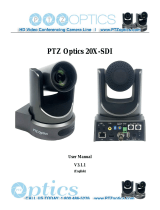
RoboSHOT HD Cameras
RoboSHOT HD Cameras - Document Number 342-0797 Page 3 of 48
TABLE OF CONTENTS
Overview ...................................................................................................................................................................................... 4
Unpacking the Camera Systems .................................................................................................................................................. 6
Image: RoboSHOT 12 HD PTZ Camera ................................................................................................................. 7
Image: RoboSHOT 30 HD PTZ Camera ................................................................................................................. 8
Image: RoboSHOT 12X and 30X Rear Panel Connections ....................................................................................... 9
Rear panel connections are identical for both models (RoboSHOT 12 shown). ....................................................................... 9
Anatomy of the Universal CCU .................................................................................................................................................. 10
Image: Front Panel CCU Controls ........................................................................................................................ 10
Image: Close up View of the Universal CCU Control Panel ...................................................................................... 10
Image: Rear Panel CCU Connections and Controls (left to right) ............................................................................. 11
RoboSHOT and Quick-Connect Universal CCU Control Menus ................................................................................................ 12
Menu Organization
.............................................................................................................................................. 12
Image: Main Menu Page ..................................................................................................................................... 12
Image: Shutter and Noise Reduction Menu ........................................................................................................... 12
Image: Wide Dynamic Range Menu ..................................................................................................................... 12
Image: Cat-5 Adjustment Menu Page ................................................................................................................... 12
Image: LCD Screen Adjustment Screen ................................................................................................................ 13
System Configuration Example .................................................................................................................................................. 13
Diagram: Basic Connectivity Example
.................................................................................................................. 13
Installation Basics:...................................................................................................................................................................... 14
Setting the RoboSHOT Camera ................................................................................................................................................. 15
Drawing: Dip Switch and Resolution Label on the Bottom of the RoboSHOT ............................................................. 15
Setting the RoboSHOT Switch Gear: ..................................................................................................................................... 15
Dip Switch Settings Further Explained (DSSFE): ................................................................................................................... 15
Setting the CCU ......................................................................................................................................................................... 15
Controlling the Camera .............................................................................................................................................................. 16
IR Remote Commander ....................................................................................................................................... 16
Telnet Control ..................................................................................................................................................... 16
The Screen Shot Tour ................................................................................................................................................................ 17
Compatible Web Browsers ..................................................................................................................................................... 17
DHCP IP Set-up (Dynamic Host Configuration Protocol) ....................................................................................................... 17
Static IP Set-up: ..................................................................................................................................................................... 17
Screen Shot: Login ............................................................................................................................................. 17
Screen Shot: Camera Control Page ..................................................................................................................... 18
Screen Shot: Storing Presets ............................................................................................................................... 19
Screen Shot: Admin login from the Camera Control Page ....................................................................................... 20
Screen Shot: Admin Menu - Camera Settings........................................................................................................ 21
Screen Shot: Admin Menu - Room Labels ............................................................................................................. 22
Screen Shot: Admin Menu - DHCP Network Configuration ..................................................................................... 23
Screen SHOT: Admin Menu - Static IP Configuration ............................................................................................. 23
Screen SHOT: Admin Menu - Security .................................................................................................................. 24
Screen Shot: Admin Menu - Diagnostics ............................................................................................................... 24
Screen Shot: Admin Menu - System ..................................................................................................................... 25
Screen Shot: Admin Menu - Update Confirmation .................................................................................................. 26
Screen Shot: Admin Menu - Update in Progress .................................................................................................... 26
Screen Shot - Admin Menu - Help ......................................................................................................................... 27
General Specifications ............................................................................................................................................................... 28
Communication Specification ..................................................................................................................................................... 29
Command Setting Values ........................................................................................................................................................... 34
Exposure Control.................................................................................................................................................................... 34
Telnet Serial Command API ....................................................................................................................................................... 35
Telnet Command List ............................................................................................................................................................. 35
Compliance and CE Declaration of Conformity - RoboSHOT HD PTZ Cameras ....................................................................... 44
Compliance and CE Declaration of Conformity - Quick-Connect Universal CCU ....................................................................... 45
Warranty Information .................................................................................................................................................................. 46
Appendix 1: Cable Pin-outs for the Quick-Connect CCU System ............................................................................................. 47






















